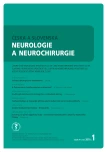Sympathetic Skin Response in the Diagnosis of Small Fibre Neuropaty
Authors:
E. Vlčková 1,2; I. Šrotová 1,2; J. Bednařík 1,2
Authors‘ workplace:
Neurologická klinika LF MU a FN Brno
1; CEITEC – Středoevropský technologický institut, MU, Brno
2
Published in:
Cesk Slov Neurol N 2016; 79/112(1): 52-60
Category:
Original Paper
Overview
Introduction:
Sympathetic skin response (SSR) is a simple and widely available test of sudomotor functions. Afferent part of this polysynaptic reflex is variable, while the efferent direction of the reflex arch is via thin unmyelinated C fibres. No reliable study of the SSR diagnostic validity in patients with sensory small fiber neuropathy (SFN) has so far been published. In clinical practice, however, we repeatedly meet patients, who have been diagnosed with SFN based solely on abnormal SSR. The aim of the study was to evaluate diagnostic validity of SSR in patients with sensory small fibre neuropathy.
Methods:
SSR was recorded from palms and soles of 69 patients with painful sensory neuropathy (33 of them with pure SFN and 36 with mixed small and large nerve fibre dysfunction) using electrical stimulation and inspiratory gasp stimuli. Small nerve fiber involvement was confirmed by reduced intraepidermal nerve fiber densities in skin biopsy samples of all cases. The results were compared with those of 89 healthy controls. The outcome for health controls were also used to establish age-stratified normative data. We assessed electric stimuli and sudden inspiration response recall end their reproducibility, amplitude and latency.
Results:
Both the SSR latencies and amplitudes showed very low diagnostic validity in small fibre neuropathy patients. The absence of SSR response represented the most reliable abnormality. However, using this parameter, dysfunction of small autonomic nerve fibres has only been found in a small part of our sensory neuropathy patients: sensitivity did not exceed 10% in pure SFN patients and 33% in those with mixed small and large nerve fibre dysfunction (where more pronounced small sensory nerve fibre involvement has previously been found).
Conclusion:
Considering its low sensitivity, SSR should not be used as the only test to confirm sensory small fibre neuropathy.
The authors declare they have no potential conflicts of interest concerning drugs, products, or services used in the study.
The Editorial Board declares that the manuscript met the ICMJE “uniform requirements” for biomedical papers.
Sources
1. Shahani BT, Halperin JJ, Boulu P, Cohen J. Sympathetic skin response – a method of assessing unmyelinated axon dysfunction in peripheral neuropathies. J Neurol Neurosurg Psychiatry 1984; 47(5): 536– 542.
2. Illigens BM, Gibbons CH. Sweat testing to evaluate autonomic function. Clin Auton Res 2009; 19(2): 79– 87. doi: 10.1007/ s10286-008-0506-8.
3. Hilz MJ, Dütsch M. Quantitative studies of autonomic function. Muscle Nerve 2006; 33(1): 6– 20.
4. Wang GH. The galvanic skin reflex; a review of old and recent works from a physiologic point of view. Am J Phys Med 1957; 36(5): 295– 320.
5. Claus D, Schondorf R. Sympathetic skin response. The International Federation of Clinical Neurophysiology. Electroencephalogr Clin Neurophysiol 1999; 52 (Suppl): 277– 282.
6. Knezevic W, Bajada S. Peripheral autonomic surface potential. A quantitative technique for recording sympathetic conduction in man. J Neurol Sci 1985; 67(2): 239– 251.
7. Baba M, Watahiki Y, Matsunaga M, Takebe K. Sympathetic skin response in healthy man. Electromyogr Clin Neurophysiol 1988; 28(5): 277– 283.
8. Arunodaya GR, Taly AB. Sympathetic skin response: a decade later. J Neurol Sci 1995; 129(2): 81– 89.
9. Bril V, Nyunt M, Ngo M. Limits of the sympathetic skin response in patients with diabetic polyneuropathy. Muscle Nerve 2000; 23(9): 1427– 1430.
10. Lacomis D. Small-fiber neuropathy. Muscle Nerve 2002; 26(2): 173– 188.
11. Wang HX, Jia ZR, Shi X, Liang W, Sun XR, Huang YN. Significance of sympathetic skin response in diagnosis diabetic small fiber neuropathy. Zhonghua Yi Xue Za Zhi 2008; 88(25): 1753– 1755.
12. Martínez-Martínez LA, Mora T, Vargas A, Fuentes-Iniestra M, Martínez-Lavín M. Sympathetic nervous system dysfunction in fibromyalgia, chronic fatigue syndrome, irritable bowel syndrome, and interstitial cystitis: a review of case-control studies. J Clin Rheumatol 2014; 20(3): 146– 150. doi: 10.1097/ RHU.0000000000000089.
13. El-Badawy MA, El Mikkawy DM. Sympathetic Dysfunction in Patients with Chronic Low Back Pain and Failed Back Surgery Syndrome. Clin J Pain 2015; in press.
14. Hoeldtke RD, Davis KM, Hshieh PB, Gaspar SR, Dworkin GE. Autonomic surface potential analysis: assessment of reproducibility and sensitivity. Muscle Nerve 1992; 15(8): 926– 931.
15. Vlckova-Moravcova E, Bednarik J, Belobradkova J, Sommer C. Small-fibre involvement in diabetic patients with neuropathic foot pain. Diabet Med 2008; 25(6): 692– 699. doi: 10.1111/ j.1464-5491.2008.02446.x.
16. Kucera P, Goldenberg Z, Kurca E. Sympathetic skin response: review of the method and its clinical use. Bratisl Lek Listy 2004; 105(3): 108– 116.
Labels
Paediatric neurology Neurosurgery NeurologyArticle was published in
Czech and Slovak Neurology and Neurosurgery

2016 Issue 1
- Memantine Eases Daily Life for Patients and Caregivers
- Metamizole vs. Tramadol in Postoperative Analgesia
- Metamizole at a Glance and in Practice – Effective Non-Opioid Analgesic for All Ages
- Memantine in Dementia Therapy – Current Findings and Possible Future Applications
- Advances in the Treatment of Myasthenia Gravis on the Horizon
Most read in this issue
- Investigation of the Retinal Nerve Fiber Layer in Multiple Sclerosis Using Spectral Domain Optical Coherence Tomography
- Sympathetic Skin Response in the Diagnosis of Small Fibre Neuropaty
- Complications of Cranioplasty after Decompressive Craniectomy
- Indications for Decompressive Craniectomy
